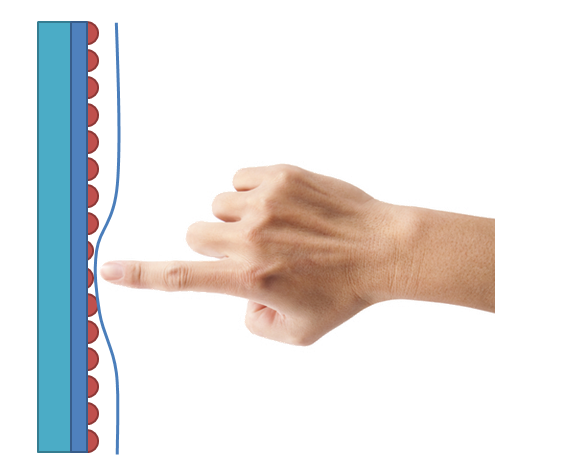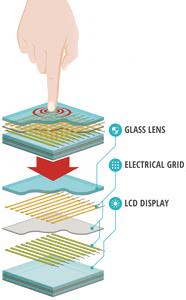Know Your Smartphone #3 : Smarphone touchscreens : simplified and explained!!!
Hello Steemians!!
Welcome to this post about smartphone displays.This post will tell you how and what exactly happens underneath those dazzling displays that we all have in our smartphones.
Before I begin there is a particular term which will be used all throughout this post which is 'capacitance'-.So what exactly is 'capacitance'?
Capacitance is defined as the ability of anything to hold a “charge”.
When we shuffle your feet across a carpet then touch a metal object and experience a static shock, that’s our body experiencing capacitance. Our body was acting as a capacitor, and storing the static electric energy picked up from the carpet.
Now lets get to the type of touchscreens which are most popular
-Resistive.
-Capacitive.

image-courtesy:www.makeuseof.com
The above image shows how the resistive touchscreen works.
A resistive touchscreen is made out of two thin layers separated by a thin gap. These are not the only layers in the resistive touchscreen, but we’ll focus on them for simplicity.
When we touch or rather press the surface of a resistive touchscreen then the upper glass material bend due to the pressure of our fingers and touches the underlying layers and as a result of this touch a voltage is passed and a touch is registered.
Resistive touchscreens are not very popular for smartphone use anymore but they are still used in ATMS,car GPS screens.As in the initial smartphone days I have used quite a few resistive touchscreens and my observation was they are not very fluid to work with and they require some amount of pressure to register a touch.
Capacitive touchscreens are what almost all the smartphone manufacturers use for their mobile devices .
Let me first tell you the screen you observe on a smartphone is not just glass but a highly engineered material.
You might have heard about Corning's gorilla glass which claims to be resistant to scratches. That is a chemically hardened material .

image-courtesy:www.ubreakifix.com
If you look at the image above you will get an idea of what the capacitive touchscreen comprises of.
A capacitive touchscreen consists of conductive grid made up of horizontal conductors and vertical conductors (as shown in the figure).These are obviously transparent and does not obstruct our view of the display lying underneath.
The grid lines are etched on opposite sides of a thin plastic insulating sheet that is glued to the back of the glass lens.
These lines intersect each other and each form a tiny capacitors(ie.they can hold charges).Remember this is all happening at a very minute level and your smartphone screen consists of a million capacitors like this.
The grid is energized when the display is on, i.e when a voltage passes through it.
Now these grid lines act like a type of coordinate system or like a map.
So how does the screen know where you have touched on the screen??
When you touch the screen the capacitance of the capacitors on that particular position changes.From there the internal circuitry will determine the contact points.
Hence our phone knows where we have touched on the screen and what we want.
So that is all for today in this post .Still a big thank you if you have read it till this far.
If you haven't seen the previous posts of this series here are the links to them
https://steemit.com/technology/@devroy/know-your-smartphone-1-soc-system-on-a-chip-simplified-and-explained
https://steemit.com/technology/@devroy/know-your-smartphone-2-memory-and-storage-explained
Please leave your comments if you want to discuss something or point out a flaw.